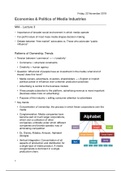Friday, 22 November 2019
Economies & Politics of Media Industries
MIA - Lecture 3
- Importance of broader social environment in which media operate
- For-profit nature of most mass media shapes decision making
- Debate between “free market” advocates vs. Those who advocate “public
influence”
Patterns of Ownership: Trends
- Tension between ‘commerce’ <—>‘creativity’
• Commerce = structural constraints
• Creativity = human agency
- Question: What kind of people have an investment in the media; what kind of
impact does this have?
• Media owners, advertisers, investors, shareholders —> Explicit or implicit
political power or influence over contents/ production practices
• Advertising is central to the business models
• If less people subscribe to the platform, advertising revenue is more important
(business relies more on advertising)
• Purpose of the industry = selling consumer attention to advertisers
- Key trends
• Concentration of ownership: the process in which fewer corporations own the
media
• Conglomeration: Media companies have
become part of much larger corporations,
which own a collection of other
companies; umbrella under which different
companies and brands operate; way of
eliminating competition
• Ex. Disney, Alibaba, Amazon, Alphabet
(Google)
• Vertical Integration: Concentration of all
aspects of production and distribution for
a single type of media product. A media
conglomerate is dominant in a single
production chain.
1





